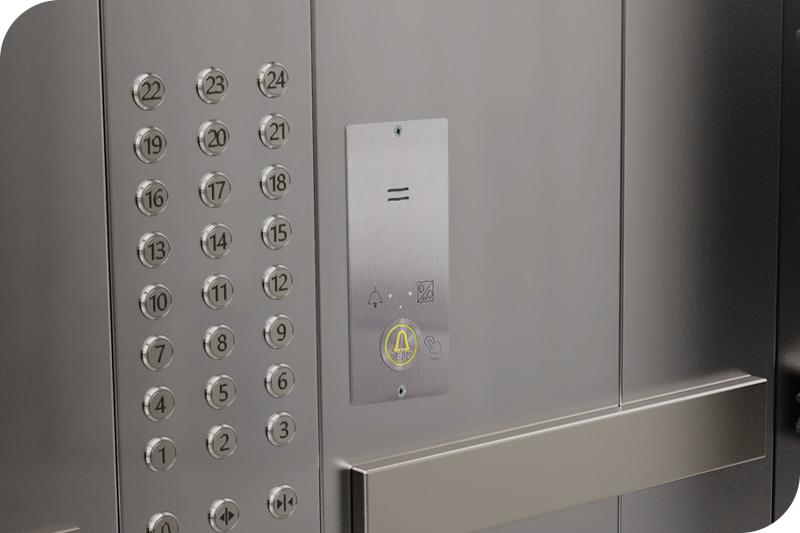Elevator Emergency Phones - a Cause for Concern?
 Jason Godwin, 23. 11. 2022 | 5 min read
Jason Godwin, 23. 11. 2022 | 5 min read
In a recent LinkedIn article “Safety Focus Article—Elevator Autodiallers” by James Mills from D2E International VT Consultants, it was noted that their post-inspection analysis pointed to some serious issues surrounding elevator autodialler malfunction affecting a massive 38% of units they tested during their iPAMS™ audits. Read on for our tips on what you can do to avoid these all-too-common problems, and how 2N can help!

71% suffered failed backup power
Backup power to emergency autodiallers became an issue as line-powered POTS/PSTN fixed connections were gradually replaced by mobile gateways requiring a power supply - meaning EN81-28 requires backup power to provide at least one hour of stand-by and 15 minutes of talk time. To ensure backup power availability all gateways typically have some way of notifying the maintenance party when batteries require replacement and usually, that messaging is via SMS. In addition, 2N’s flagship 2N® EasyGate IP gateway also communicates battery status through the 2N® Elevator Center cloud application which gives any operator a complete view of the gateway status. However, in case of backup power degradation or failure, if the warnings are not acted upon immediately and are dismissed, forgotten, or left to the next planned site visit then in the event of a power failure, the elevator passengers will find the autodialler not functioning and be put through an ordeal that could have been avoided.
To mitigate this, consideration should be given to widening the audience for the SMS warnings to include building management. With the 2N® Elevator Center cloud application, you can also set email alerts which would act as a double notification system for key people. A more radical step is to mount the gateway outside of the elevator domain in common areas of the building. Be sure to do this in a way that makes it not only secure but also accessible to building management staff. They can check battery status and vociferously hold maintenance companies to account when backup power warnings are ignored.
25% failed to operate under backup power and under normal circumstances
EN81-28 requires the autodialler to simulate an elevator alarm through to the response centre every three days - and the resolution of a test elevator alarm failure should be acted upon as a matter of priority. As it’s statically unlikely that all 25% of failures were within a 3-day window – this means that the failures in the tests were not being flagged and acted upon. Post-installation and testing, an autodialler failure is likely due to programming errors or gateway SIM cards being unable to communicate due to account suspension or lack of credit.
To address the first issue 2N works with distributors and directly with OEMs to create auto-configuration files or templates that need only uploading to the autodialler locally, or from a central location, in order for all autodialler units under management to function properly. If you want to solve the second issue, the 2N® EasyGate IP gateway communicates 24/7 with 2N’s cloud-based 2N® Elevator Center, showing and flagging any issue with the backup power (or the mobile connectivity) immediately. Since data is required to be transmitted constantly, it allows for faster problem resolution without the need to wait for an elevator alarm test call failure – and is available to all customers.
4% had reported issues with two-way communication
Effective communication once an elevator alarm is activated of course requires that the elevator passenger(s) can hear the response centre, and vice-versa. EN-81 also requires that the voice communication equipment be adjustable to suit site conditions, too. Therefore the microphone and speaker gains should be set and tested end-to-end at the time of autodialler installation. 2N autodiallers come pre-adjusted to a elevator cab background noise norm and the parameters can be further adjusted locally, or indeed remotely. Generally, however, they should not need adjustment unless environmental noise conditions are poor.
In summary, though elevators are the safest form of transport and very reliable - there are elements that still require human oversight and intervention. The autodialler is a good example and it’s one of the most important elements from a user experience and safety perspective in emergency situations. The findings of the D2E International VT Consultants serve as a testament to the value of consultant maintenance audits, and a reminder for maintenance companies that there’s more to do. As for autodialler manufacturers like 2N – we will continue to innovate and simplify!